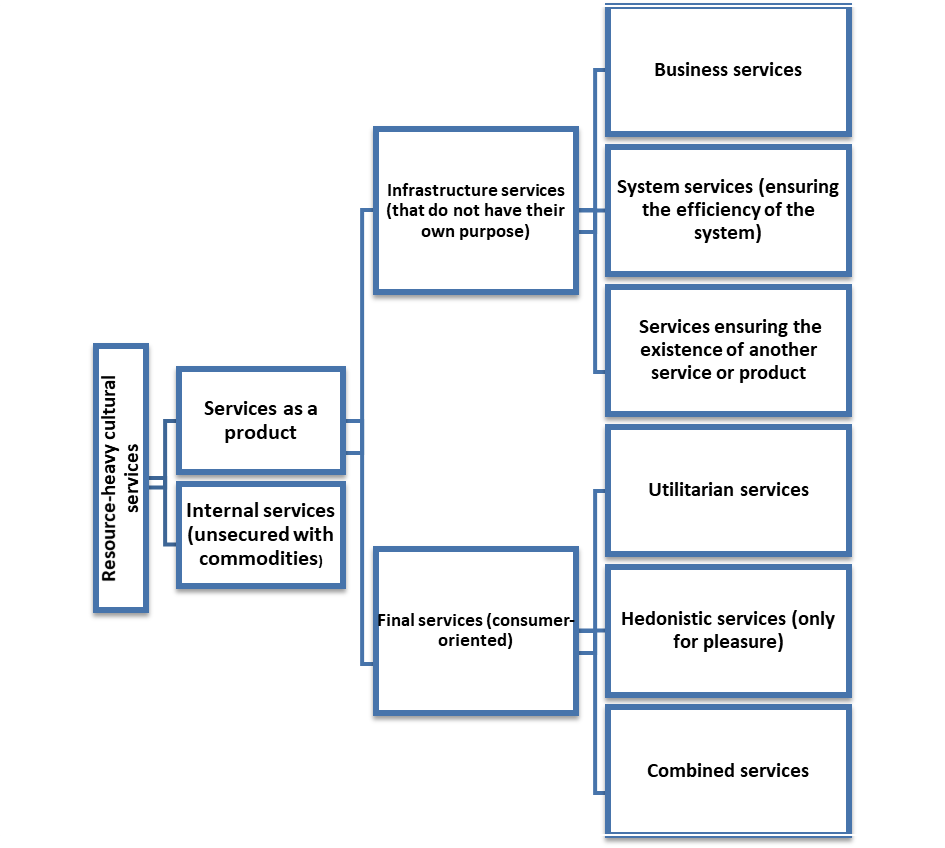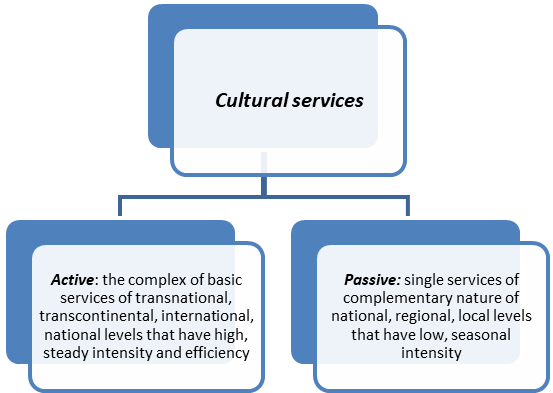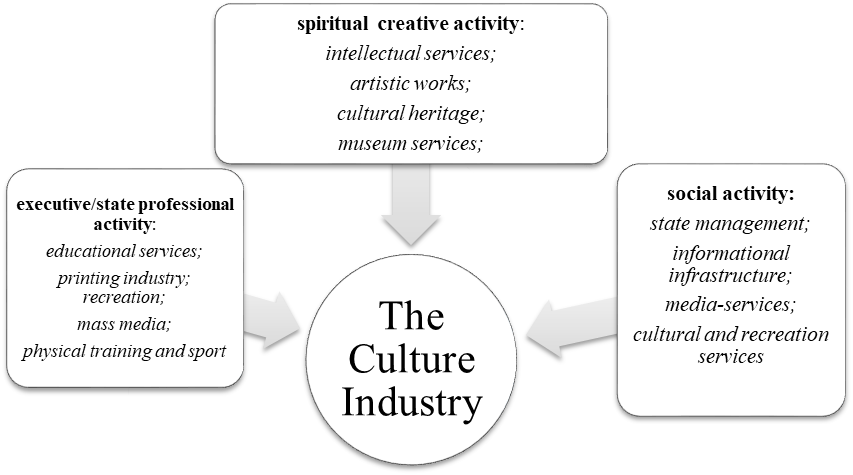Abstract
The research task is to analyze the theoretical grounds of the developing Russian culture industry; to propose the author's classification of culture services for resource-heavy (services as a product; services unsecured with commodities) and resource-light, for active and passive. Resource-heavy services (material-intensive, energy-intensive, labor-intensive) stand in close relation to the beneficial effect on the size, amount of material costs and quality of produced labor. The author defines the culture industry, the structure and relationship of markets and sub-markets of the cultural sphere. The structure of the culture industry can be presented as a collection of sub-markets and it is possible to determine the indicators of cultural organizations' activity. The author proposes the differentiation of services into "artistic" and "creative" following the culture industry's areas of responsibility. Artistic industries belong to the area of responsibility of socio-economic relations and creative high-tech intellectual products belong to the area of responsibility of material-economic relations. The problems of the culture industry's material-economic development can be solved only upon the condition of national management of all culture industry sectors. Methodically, the study is based on the fundamental scientific works and the functioning of the cultural and creative sphere, the specifics of cultural activity, and the work on the system analysis of processes and relations in the cultural sphere.
Keywords: Classification of servicesculture industrydegree of activitysub-markets
Introduction
The global economic decline requires maximizing the use of resource potential and the adoption of verified organizational and economic management mechanisms. The examples of global experience in enhancing the competitive advantages of regions is “the creative industry”, that can provide 5 – 15% Gross Regional Product growth (GRP). With the development of the creative industry, a particular region's economy and social situation become steadier. For example, in Berlin the creative segment of the economy provides 22% of city budget income. The situation is similar in France, Uzbekistan, England, etc. The degree of service industry development has become a criterion that characterizes the development of society. According to the US Bureau of Labor Statistics, the further increase in the number of available jobs will occur only in the service industry. The corresponding dynamics is observed in European countries where a significant part of governmental grants directed to the culture industry directly or indirectly return to the state (Tabellini, 2016).
According to recent statistics, trade in cultural and artistic products in the European Union as a complex materialized element of the cultural and creative industry is quite varied in consumer properties of cultural products, structure and specialization of economic sectors in different member states. These technological innovations are the basis of new consumption trends.
Cultural activity and heritage are of great importance to the economy (Throsby, 2018), society (Harrison, 2018) and the environment of the whole world (Beugelsdijk & Maseland, 2016). The preservation, assessment, and development of this value require developing a strategy in cultural activity and heritage – a strategy in which the culture is considered a key asset and the most critical resource (Horkheimer & Adorno, 2016). Such a strategy should be fully integrated into the state's key economic priorities as set in the national development strategy until 2030. This strategy should facilitate cultural contributions to sustainable development programs, creative activities, research and innovations, environmental change, energy conservation, regional development, and territorial cohesion.
In recent decades, urban and cultural policies were implemented as a rule with models, including models of creative economy (Bourbieu, 2019), creative and knowledge-intensive industries, creative cities, and incubation centers, co-working spaces, and comprehensive ecosystems at different scales but without taking into account the impact of cultural activities on the local community and territory by this process of change. The knowledge and innovation growth has prevailed to support the economic development, while the concern for socio-cultural processes is often left behind. According to modern research, it is recommended to study the dynamics and goals of cultural and creative initiatives (Enzensberger, 2016) programs connected with the social and material urban environment. In terms of cultural implications, the wants are integral to this direction. Therefore, the user value of the eventual outcome of the activity is caused by the ability to satisfy cultural needs in both material and immaterial ways. The scope of consideration of cultural, economic relations includes only those "cultural goods that have user value and satisfy genuine (socially accepted) cultural needs” (Rubinstein, 2019, p. 32).
Problem Statement
In order to determine the structure of sub-markets and the limits of the cultural sphere, the research task is to analyze the theoretical grounds of the developing Russian culture industry, to discover sub-markets of the cultural sphere and indicators of the cultural organizations' activity; to propose the author's classification of cultural services
Research Questions
In modern scientific terms, "culture services" are interpreted mainly through:
creative potential realized as the final output of artistic creativity;
economic nonmaterial product sold in the market as a special information product.
The differentiation of culture services by "artistic" and "creative" following the areas of responsibility of the culture industry classifies artistic industries as the area of responsibility of socio-economic relations and innovative high-tech intellectual products to the area of responsibility material-economic relations. The use of united intellectual and creative abilities of all producers of the cultural services market can ensure society's sustainable development in general and the cultural industries in particular (Malshina & Filonenko, 2019).
It is possible to divide the sphere of Russian culture into main activities:
1.organizational and economic infrastructure;
2.preservation and use of cultural and historical heritage;
3.artistic education;
4.cultural processes.
The model of culture industries is concentrated around the art industry and with distance, all of the other industries are different in the degree of creativity:
1.creative industries whose products are considered cultural goods but which also produce other non-cultural goods and services;
2. industries are mainly operating outside the cultural sphere but producing products that can have some cultural content.
The whole variety of classifications of cultural goods is divided into two main groups: “material objects for the formation and satisfaction of cultural needs; nonmaterial objects for the formation and satisfaction of cultural needs” (Malshina, 2016, р. 45) (Table
Cultural goods determine each other and form a set of conditions for cultural production and consumption. The criterion for the inclusion of cultural goods in the culture industry can determine the sales profit of goods and services of a socio-progressive creative orientation.
Purpose of the Study
In order to determine the structure of sub-markets and the limits of the cultural sphere the research task is to analyze the theoretical grounds of the developing Russian culture industry.
Research Methods
Methodically, the study is based on the fundamental Russian (Muzychuk, 2019); (Rubinstein, 2019) and foreign (Adorno, 2020); (Throsby, 2018) scientific works and on the functioning of the cultural and creative sphere (Barro & McCleary, 2018), the specifics of cultural activity (Granato et al., 1996); (Harrison, 2018) as well as the work on the system analysis of processes (Begelsdike & Maseland, 2016) and relations in the cultural sphere (Swank, 1996).
The study uses analysis, induction and deduction, systematization, structuring, classification as well as the methods of institutional, economic analysis.
The two main approaches to the systematization of a range of services in the cultural industry system express:
1) The formation of a two-level structure of the list of services consisting of an industry list of services and a departmental one. This approach can be applied if there is a regional program of socio-economic development in the constituent entity of the Russian Federation;
2) The formation of a national list of services in order to produce tasks for subordinated authorities.
Based on the analysis, the service system is structured according to the main groups: basic and additional (individual, exclusive). Basic services should include “the entire list of services confirmed by federal laws, additional – services provided at the request of the consumer and not included in the basic” (Begelsdike & Maseland, 2016, р. 43).
Systematic approach to the service area presents this type of activity as a hierarchical socio-economic and scientific.
Findings
For the convenience of further application of organizational and economic measures to the management of the whole variety of cultural services the author proposes to classify culture services for “resource-heavy and resource-light”. “Resource-heavy services (material-intensive, energy-intensive, labor-intensive) stand in close relation of the useful effect to the size, amount of material costs and quality of produced labor. All culture services belong to resource-heavy services” (Malshina, 2016, p. 50) (Figure

Culture services “sold as goods tend to be non-gratuitous and cultural services not sold as goods have no material component, i. e. they are material” (Malshina, 2016, р. 55). Cultural infrastructure services can provide a single unit or other service, the functioning of not one type of service or production but of the entire individual stage process – business service aimed at servicing of business processes. They can also increase the efficiency of the system as a whole. This type of services is the most adapted for the organization of business process, logistics interaction and investment.
The result of the production of cultural services can both have independent consumer value and acquire it during consumption as well as combine both components.
Based on the criterion of activity of the use of cultural services, an author’s modification in the general classification is possible: active and passive (Figure
A low utilization characterizes passive services, therefore, reduced arrival rate and the lowest system capacity what is common to a passive strategy for the development of the service market. Active participants in the cultural services market provide active services. They independently implement the results of their activity or the activity itself (information, educational, financial and transport services etc.) and actively influence the cultural services market i. e. interact with other programs, projects. Passive participants of the cultural services market who do not independently implement the results of their activity in the services market can provide passive services (providing, energy services). The same service can be passive and active for different subjects of the cultural services market. This situation of cultural services depends on the basic activity of the market subject.

The innovative components of active services influence connected services by creating prices, smooth production flow and sale of services, etc.
Passive services are characterized by a low utilization, therefore, reduced arrival rate and the lowest system capacity what is common to a passive strategy for the development of the service market. Active participants in the cultural services market provide active services. They independently implement the results of their activity or the activity itself (information, educational, financial and transport services etc.) and actively influence the cultural services market i. e. interact with other programs, projects. Passive participants of the cultural services market who do not independently implement the results of their activity in the services market can provide passive services (providing, energy services).
The same service can be passive and active for different subjects of the cultural services market. This situation of cultural services depends on the basic activity of the market subject.
Conclusion
Taking as a basis the selected enlarged groups of socio-cultural needs of the society, the structure of the culture industry can be presented as a collection of sub-markets and it is possible to determine the indicators of the activity of cultural organizations. (Table
The proposed division into sub-markets is conditional since in general the cultural services are complex and interact with at least two sub-markets.
It seems possible to characterize the culture industry as a complex business structure – to gain profit through the production and circulation of texts in the process of relations between diverse markets (Figure
The modern progressive integration of society, culture, and business requires new mechanisms to ensure the Russian Federation's development of culture industries. Thus, executive/state/professional activity includes state and municipal types of services provided by executive and local authorities governed by the Russian Federation's laws provided to individuals and legal entities. The list of management services is approved by federal legislation and includes cultural services. The services of spiritual creative activity include types of services provided by service market entities of moral and cultural significance aimed at self-actualization, moral and creative development etc. Social services include the types of services provided by cultural market entities to meet vital need (socially important). The list of minimum social services is approved by federal legislation and includes some social and cultural services.

Based on diversity of the culture industry services some types of services may belong to two or more service markets. For example, educational, print and mass media services are provided by governmental authorities and are of spiritual and moral importance, i. e. they are at the intersection of two sub-markets.
Each type of sub-markets requires certain instruments and management mechanisms; the identified features imply an improvement in the culture industry's management mechanism. Depending on sub-markets, different types of resource flows are involved in producing and consuming cultural services. The use of the author's classification of the culture industry services according to the criterion of activity, structure and relations of the culture industry market will contribute to further development of the categorical framework of the cultural services system what will facilitate resource support for each type of cultural services based on their specificity.
Acknowledgments
The study was conducted with financial support from the Russian Federal Property Fund, project № 19-010-01004/20 «The Development of Organizational, Economic and Financial Mechanisms for Support and Strategic Development of the Cultural Industry in Russian Regions».
References
- Adorno, T. (2020). The study of the authoritarian character. Moscow: Silver threads.
- Barro, R. J., & McCleary, R. (2018). Religion and Economic Growth across Countries. American Sociological Association, 68(5), 760-781.
- Begelsdike, S., & Maseland, R. (2016). Culture in economic science. History, methodological reasoning and areas of practical application in modernity. Moscow: Saint Petersburg: publishing House: International relations.
- Bourbieu, P. (2019). Economic anthropology: a course of lectures at the Collège de France (1992-1993). Moscow: publishing house "Delo" Ranepa.
- Enzensberger, N. M. (2016). The consciousness industry. Elements of media theory. Moscow: Ad Marginem Press.
- Granato, J., Inglehart, R., & Leblang, D. (1996). The effect of cultural alues on Economic Development: Theory, Hypotheses, and Some Empirical Tests. American Journal of Political Science, 40(3), 625-628.
- Harrison, L. E. (2018). Who prospers? How cultural values shape economic and political success. Moscow. New publishing house.
- Horkheimer, M., & Adorno, T. (2016). The culture industry. Enlightenment as a way to deceive the masses. Moscow: Ad Marginem Press.
- Malshina, N. A. (2016). Cultural Services-main classifications. Scientific review. Economics, 3, 42-55.
- Malshina, N. A., & Filonenko, A. A. (2019). Contemporary analysis of the influence of modern trends in the development of post-industrial society on the dynamics, development and structural transformation of the cultural and creativity industry. Proceedings of the 4th International Conference on Contemporary Education, Social Sciences and Humanities (ICCESSH 2019), 1682-1687. https://www.atlantis-press.com/proceedings/iccessh-19
- Muzychuk, V. Yu. (2019). Financing Culture in Russia: A Step Ahead and Two Backwards… Journal of the New Economic Association, 1(41), 208–215.
- Rubinstein, A. Ya. (2019). Financing of patronized goods in the humanitarian sector of the economy (experience of institutional research). The economy of modern Russia, 86(3), 62-77.
- Swank, D. (1996). Culture, institutions and Economic Growth: Theory, Recent Evidence, and the Role of Communitarian Polities. American Journal of Political Science, 40(3), 660–679.
- Tabellini, G. (2016). Culture and Institutions: Economic Development in the Regions of Europe. Journal of the European Economic Association, 8(4), 677–716.
- Throsby, D. (2018). Economics and culture. Moscow: Dom Publishing house. Higher school of Economics.
Copyright information

This work is licensed under a Creative Commons Attribution-NonCommercial-NoDerivatives 4.0 International License.
About this article
Publication Date
16 April 2021
Article Doi
eBook ISBN
978-1-80296-104-1
Publisher
European Publisher
Volume
105
Print ISBN (optional)
-
Edition Number
1st Edition
Pages
1-1250
Subjects
Sustainable Development, Socio-Economic Systems, Competitiveness, Economy of Region, Human Development
Cite this article as:
Malshina, N. (2021). The Allocation Of The Boundaries Of The Russian Culture Industry. In E. Popov, V. Barkhatov, V. D. Pham, & D. Pletnev (Eds.), Competitiveness and the Development of Socio-Economic Systems, vol 105. European Proceedings of Social and Behavioural Sciences (pp. 628-637). European Publisher. https://doi.org/10.15405/epsbs.2021.04.67

